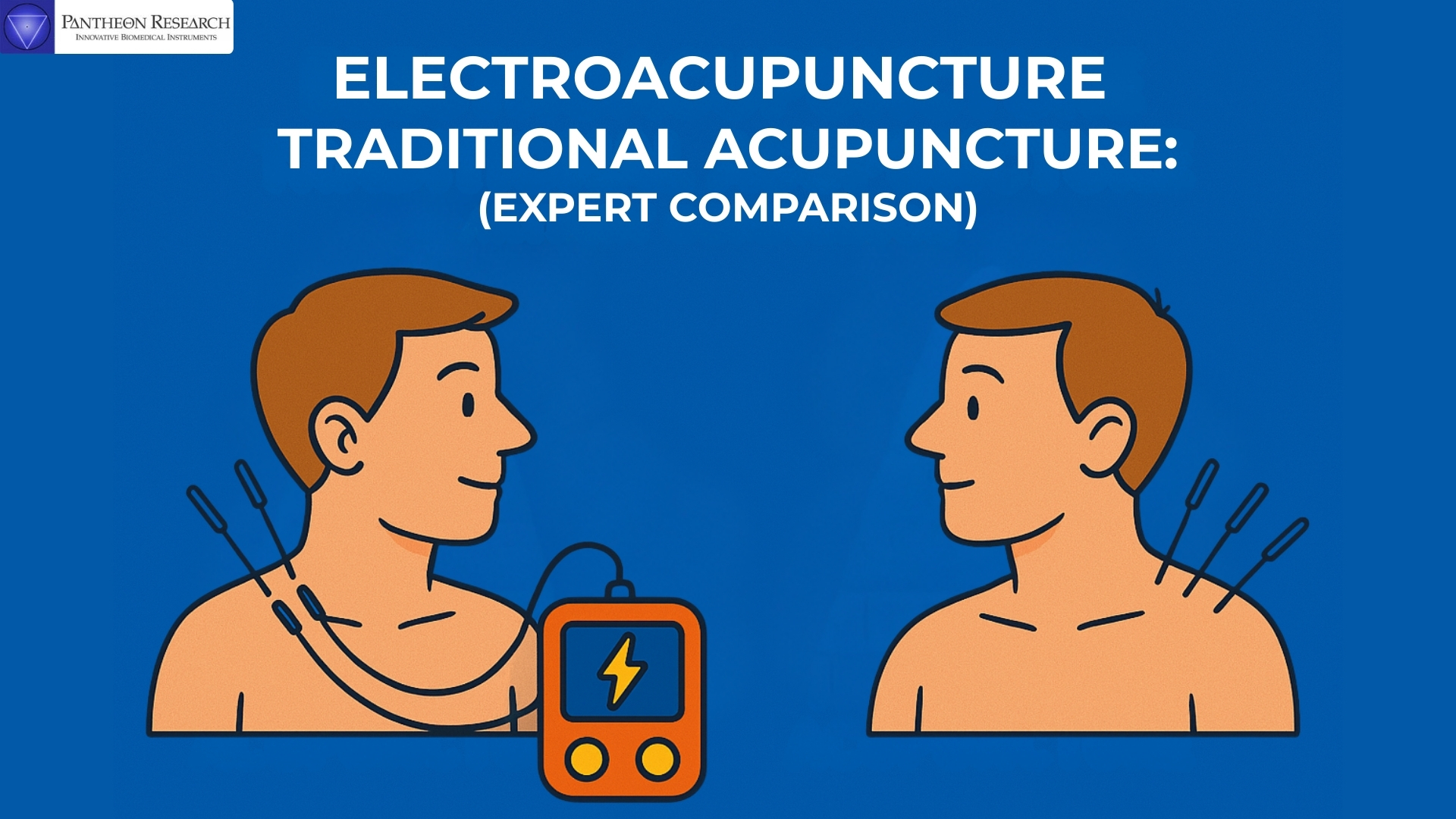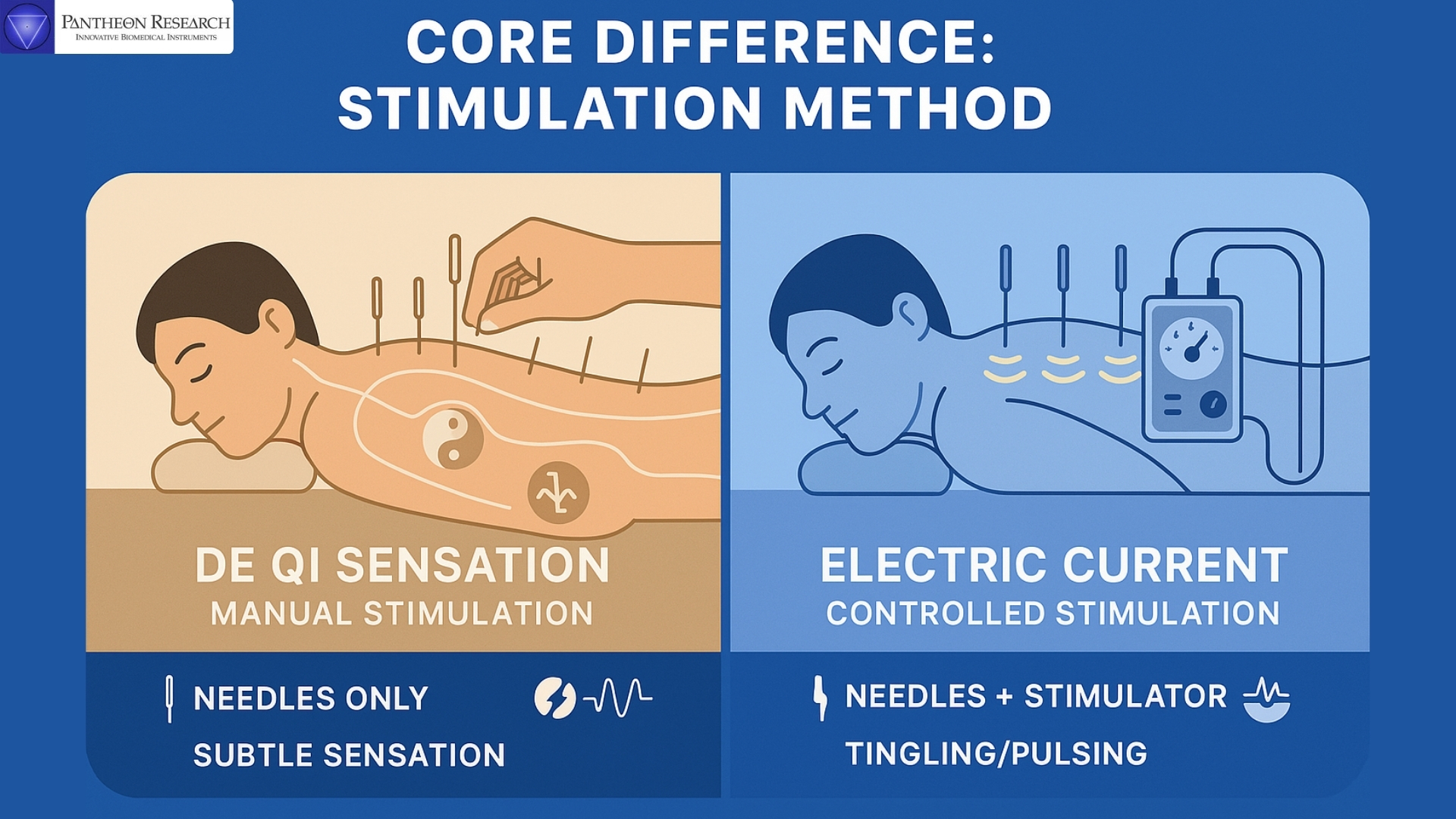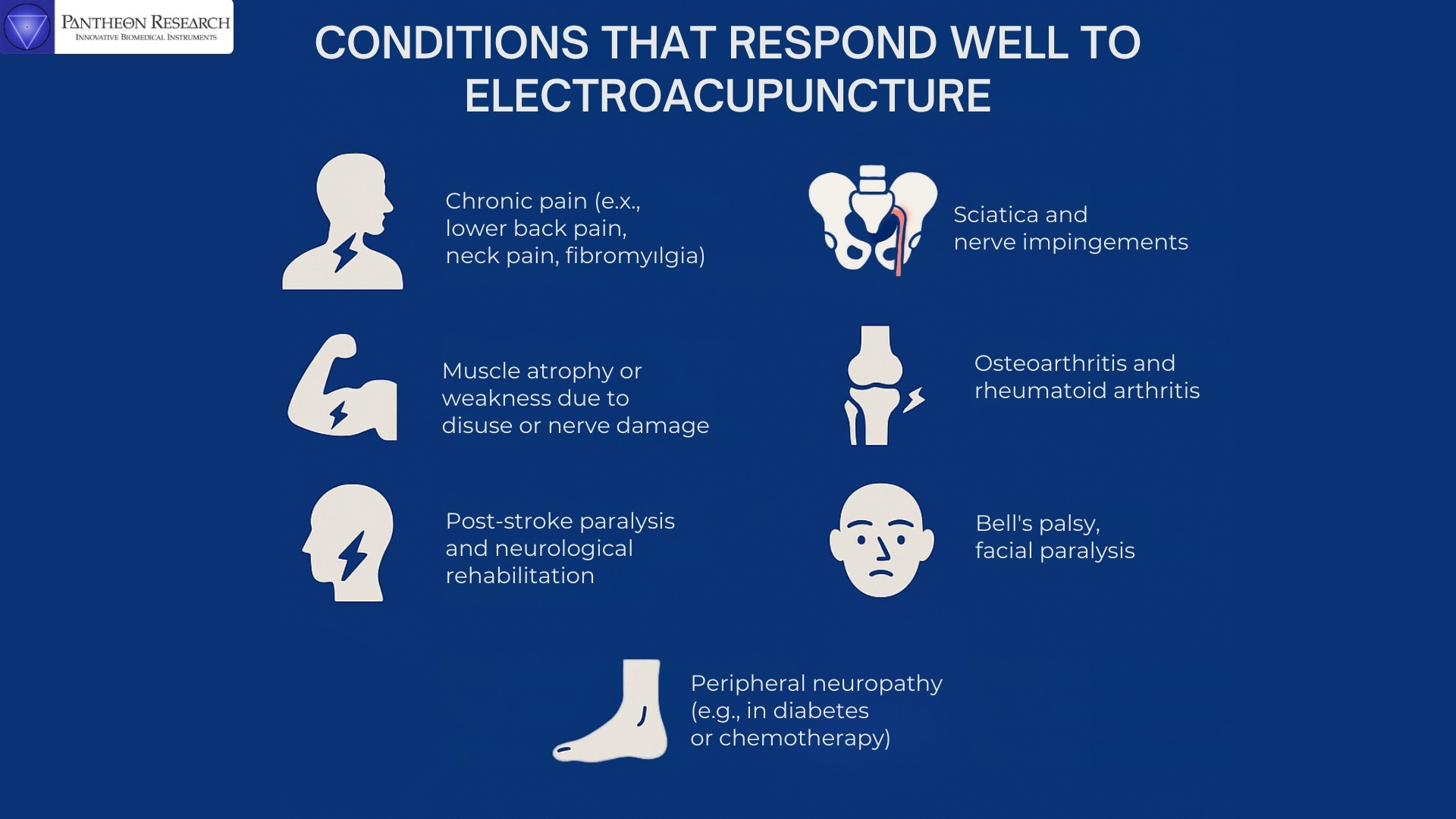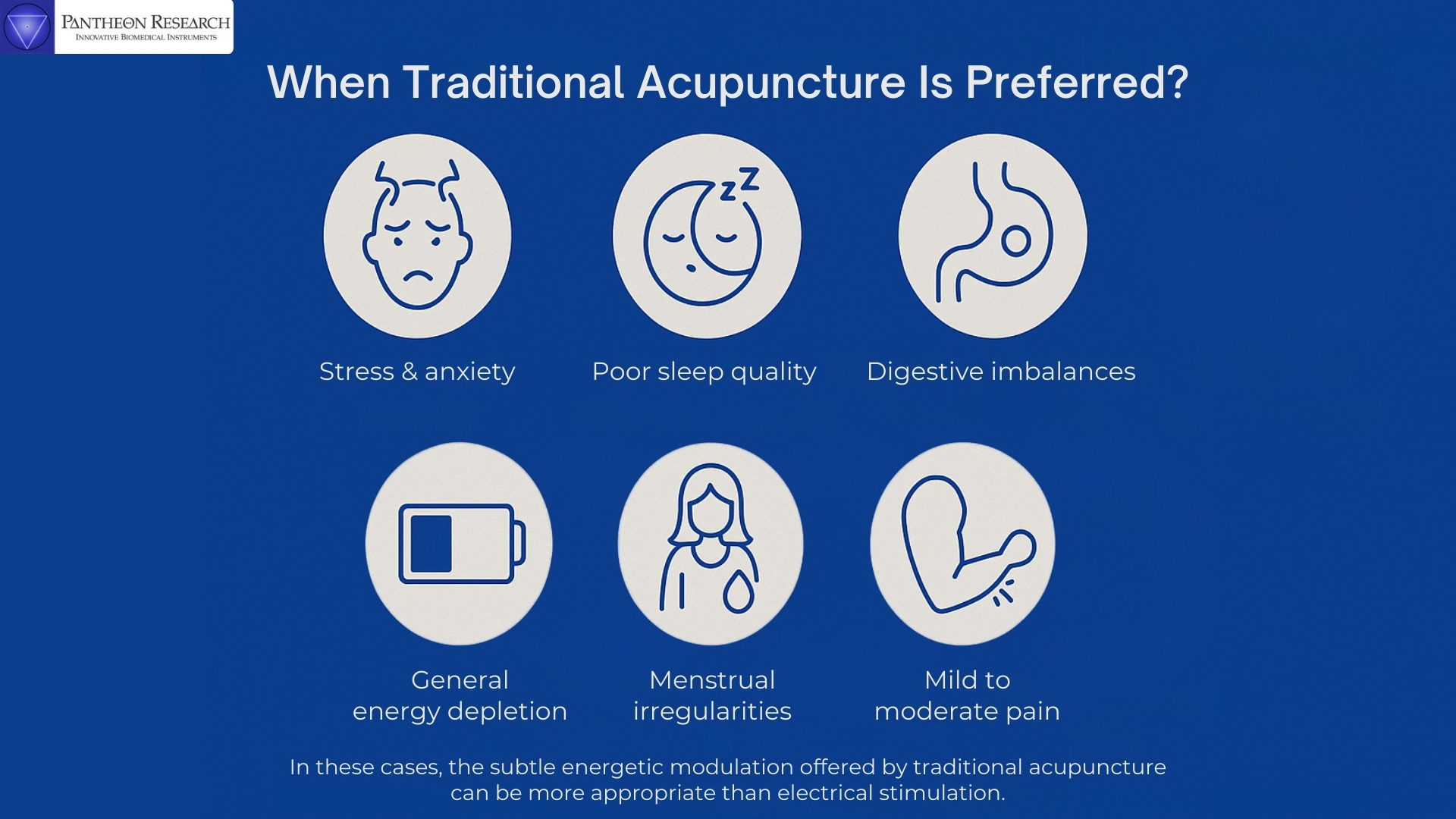Electroacupuncture vs Traditional Acupuncture: Expert Comparison
Posted by John Hubacher on Mar 31st 2025

Electroacupuncture is gaining serious momentum in modern clinical settings—not as a replacement for traditional acupuncture, but as an evolution of it. As technology advances and patient needs shift toward faster, evidence-supported results, many clinics are re-evaluating their modalities.
Traditional acupuncture has long stood the test of time, rooted in centuries of Eastern medicine and focused on restoring the body’s natural energy flow. Electroacupuncture, on the other hand, integrates low-voltage electrical stimulation with needle insertion—offering enhanced outcomes for certain conditions, especially those involving pain, inflammation, or neurological deficits.
This article breaks down both approaches—not with fluff, but with clinical clarity. Whether you’re a licensed acupuncturist, integrative physician, or rehab specialist, this comparative guide will help you understand when to use electroacupuncture, when to rely on traditional methods and how to make the right decision for your patients and practice.
What Is the Core Difference Between Electroacupuncture and Traditional Acupuncture?
At their core, both electroacupuncture and traditional acupuncture involve inserting fine needles at specific points on the body to stimulate healing. However, the key distinction lies in the method of stimulation.

✅ Traditional Acupuncture:
- Based on the principles of Traditional Chinese Medicine (TCM), which views health as a balance of energy (Qi) flowing through meridians.
- Practitioners manually manipulate the needles to elicit a response known as De Qi, a dull or heavy sensation.
- The technique is subtle, relying on energetic shifts, pulse reading and practitioner intuition.
✅ Electroacupuncture:
- Involves attaching electrodes to the inserted acupuncture needles and delivering a controlled electric current.
- Frequency and intensity can be adjusted to suit the therapeutic goal—whether stimulating nerves, relaxing muscles, or enhancing blood flow.
- Often used for treating neurological conditions, chronic pain, muscle atrophy and post-stroke rehabilitation.
⚙️ Technique, Sensation & Equipment:
- Traditional acupuncture relies solely on needle placement and manual manipulation.
- Electroacupuncture requires a stimulator device, cables and knowledge of frequency protocols.
- Patients often report a gentle pulsing or tingling sensation rather than the stillness of traditional needling.
If you’re unfamiliar with how electroacupuncture works - especially in terms of its clinical evolution, stimulation techniques & treatment mechanisms - you may want to explore our Complete Beginner’s Guide to Electroacupuncture, which covers the fundamentals in detail.
When Is Electroacupuncture More Effective?
While traditional acupuncture offers a time-tested approach for restoring balance and wellness, electroacupuncture is often preferred in cases requiring deeper stimulation, faster results or neurologically-targeted therapy.
Conditions That Respond Well to Electroacupuncture
Clinical research and practitioner reports support the use of electroacupuncture in treating:

- Chronic pain (e.g., lower back pain, neck pain, fibromyalgia) — One study on chronic low back pain found electroacupuncture to significantly reduce pain intensity and improve mobility compared to traditional methods.
- Sciatica and nerve impingements
- Muscle atrophy or weakness due to disuse or nerve damage
- Post-stroke paralysis and neurological rehabilitation — Evidence shows promising outcomes in neurofunctional recovery, especially in subacute stroke patients (PubMed).
- Osteoarthritis and rheumatoid arthritis — Comparative trials suggest better symptomatic relief with electroacupuncture, particularly for knee osteoarthritis.
- Bell’s palsy, facial paralysis
- Peripheral neuropathy (e.g., in diabetes or chemotherapy)
Why Electrical Stimulation Makes a Difference?
The microcurrents applied in electroacupuncture can:

- Increase local blood flow, aiding tissue healing
- Stimulate nerve conduction in damaged pathways
- Regulate neurotransmitter release involved in pain, mood and motor function
- Enhance muscle contractions, which supports rehabilitation and recovery
These effects are attributed to mechanisms like Aβ and Aδ fiber activation, endorphin release and modulation of inflammatory pathways. Modern neurophysiological studies support these claims, showing that electroacupuncture can influence both peripheral and central nervous systems.
Should I Try Electroacupuncture If Traditional Acupuncture Didn’t Work?
Yes - in many cases, electroacupuncture is the next logical step. It builds on traditional techniques but introduces a more potent, targeted stimulus that may help overcome treatment plateaus—particularly in chronic or complex conditions involving nerves or muscle.
However, success also depends on:
- The accuracy of the underlying diagnosis
- Practitioner knowledge of stimulation protocols
- The patient’s overall health, nerve sensitivity & tolerance
Traditional Acupuncture: Where It Excels
Despite the rise of electroacupuncture, traditional acupuncture remains the gold standard in many clinical and wellness settings—especially for cases where energetic balance, emotional regulation, or gentle intervention is key.
When Traditional Acupuncture Is Preferred?
Traditional acupuncture is often more effective for:

- Stress and anxiety
- Insomnia or poor sleep quality
- Digestive imbalances (e.g., IBS, bloating, acid reflux)
- Fatigue or general energy depletion
- Menstrual irregularities or hormonal support
- Mild to moderate pain, particularly when linked to emotional tension or musculoskeletal imbalances
In these cases, the subtle energetic modulation offered by traditional acupuncture can be more appropriate than electrical stimulation.
The Strength of Subtlety
Traditional acupuncture focuses on restoring the smooth flow of Qi through the body’s meridians. The practitioner uses refined techniques like:
- Pulse and tongue diagnosis
- Needle sensation feedback (De Qi)
- Balancing Yin and Yang energies
This allows for customized, holistic treatments that consider emotional states, sleep patterns, digestive health and overall vitality—not just the presenting symptom.
Many patients also prefer traditional acupuncture when:
- They’re new to needling and unsure about electrical sensations
- Their condition requires a gentle, non-invasive approach
- Emotional well-being is central to the treatment goal
Practitioner-Patient Connection
Another advantage of traditional acupuncture is the depth of practitioner interaction. Because treatments are manual and diagnostic tools are subtle, the practitioner’s skill, intuition and rapport play a central role in therapeutic success.
Key Comparative Factors for Modern Clinics
Choosing the right acupuncture modality depends on the condition, patient profile, clinic resources and treatment goals. Here's a quick reference table to help clinics compare both methods:
|
Factor |
Electroacupuncture |
Traditional Acupuncture |
|
Treatment Efficiency |
Faster symptom relief for pain & nerve issues; may need fewer sessions |
Slower, holistic healing; ideal for long-term wellness and stress |
|
Equipment & Setup |
Requires stimulator device, wires, training; higher upfront cost |
Minimal setup; lower cost and easy to integrate |
|
Patient Sensation |
Tingling or pulsing; more tech-involved experience |
Subtle, calming needle sensations; more meditative |
|
Best For |
Chronic pain, neurological rehab, arthritis, muscle atrophy |
Stress, digestion, emotional wellness, fatigue |
|
Scientific Backing |
Supported by clinical studies for measurable conditions |
Backed by historical data and lifestyle medicine success |
Contextual Considerations Still Matter
While tables offer quick decision support, they don’t capture the clinical nuance behind each factor:
- A patient with nerve pain and anxiety might benefit from hybrid treatment (electro + traditional).
- Smaller practices may start with traditional acupuncture due to logistics and cost, then integrate devices as demand grows.
- First-time patients may feel more at ease with gentler traditional methods, even if electroacupuncture is technically more effective for their condition.
Bottom line: Both methods have a place. Use this table as a starting point, then customize your approach based on patient needs, condition & practitioner expertise.
Electroacupuncture Devices for Professional Use
Clinics integrating electroacupuncture into their practice must carefully select devices that offer precision, safety and treatment versatility. Below are clinical-grade tools designed for acupuncture professionals, with attention to varying skill levels and patient needs.

All devices mentioned in this guide are designed to meet professional standards of safety and precision. As a leading innovator in the field, Pantheon Research develops advanced electro acupuncture machines trusted by clinics for their accuracy, reliability and ease of use.
Electrostimulator 4c.Pro – Simplicity Meets Reliability
The Electrostimulator 4c.Pro is a compact, beginner-friendly device with four channels delivering milliampere currents (0–15 mA). It features:
- Simple control interface
- No-shock start function
- Built-in safety alerts
This model is ideal for clinics focusing on muscle stimulation and pain relief with minimal setup or training requirements.
Electrostimulator 8c.Pro – Multi-Channel Flexibility
The Electrostimulator 8c.Pro offers eight channels—4 delivering milliampere current and 4 delivering microcurrent (up to 600 µA).
Key features include:
- Symmetrical biphasic waveform for balanced stimulation
- Dual current outputs for broader therapeutic scope
- Calibrated frequency precision (99.94%)
This device suits clinics treating a wide range of musculoskeletal and systemic conditions, where flexibility and precise control are required.
12c.Pro Advanced Electrostimulator – Precision for Complex Treatments
- The 12c.Pro Advanced Electrostimulator features twelve independent channels (6 milliampere, 6 microcurrent), allowing simultaneous stimulation across multiple acupuncture points.
Highlights include: - Programmable frequency controls
- Pulse Width Modulation & Sweep Function for enhanced targeting
- Clip lead tester and battery safety alerts
Engineered for practitioners who deliver advanced protocols or manage complex, multi-site treatment cases.
Clinical Microcurrent Stimulator – For Facial Rejuvenation & Spa Applications
The Clinical Microcurrent Stimulator is not intended for use with acupuncture needles, but it’s highly effective for aesthetic and skin-toning treatments. It provides:
- Adjustable current, polarity and frequency
- Dual output channels
- Compatibility with TENS pads and facial probes
- Rechargeable battery for portability
Used in facial contouring, toning and anti-aging, this technology mimics the body’s natural bioelectrical current. Because it's sub-sensory, treatments are soothing and often completely undetectable to clients.
Bonus Value: Every purchase includes a complimentary 12 CEU Distance Course on using microcurrent for facial rejuvenation- ideal for aestheticians and acupuncturists expanding into aesthetics.
Often referred to as the “5-minute facial-lift,” microcurrent therapy is FDA-cleared, non-invasive & increasingly popular in spas and integrative skin clinics.
Training and Practitioner Support
To ensure safe and effective clinical use, each device is supported by structured training:
- Electroacupuncture Training – Covers treatment protocols, electrical safety & condition-based prescriptions
- Microcurrent Therapy Training – Focuses on facial rejuvenation, skin applications and aesthetic uses
All devices are frequency-calibrated to 99.94% accuracy, with built-in safety features that support reliable clinical outcomes.
Choosing the Right Modality for Your Clinic
There’s no one-size-fits-all solution—choosing between electroacupuncture and traditional acupuncture depends on:
- Your patient base (e.g., pain-focused vs. wellness-focused)
- Practitioner expertise and comfort with technology
- Clinic resources, including equipment, space and training
Many clinics find success in using both modalities: starting with traditional acupuncture to establish trust and baseline results, then introducing electroacupuncture when deeper or more targeted stimulation is needed.
The most effective approach is one that prioritizes:
- Informed consent
- Evidence-based application
- Ongoing patient feedback and treatment adaptation
In practice, the most successful clinics align their treatment strategies with both clinical logic and individual patient needs—regardless of modality.
Frequently Asked Questions
Q1: Is Electroacupuncture More Painful Than Traditional Acupuncture?
No, electroacupuncture is not more painful, but it feels different. After needles are inserted, a low-level electric current creates a pulsing or tingling sensation. Most patients describe it as unusual but not uncomfortable. Unlike sharp shocks, the stimulation is controlled and sub-threshold. Traditional acupuncture, by contrast, often involves a dull, warm, or heavy feeling known as De Qi, without any electrical input.
⚠️ If the patient feels discomfort, current intensity should be reduced immediately.
Q2: Can Electroacupuncture Be Used for Anxiety or Depression?
Electroacupuncture has shown potential in some studies to support mood regulation by affecting neurotransmitters like serotonin and dopamine. However, traditional acupuncture is more commonly used for anxiety and depression due to its emphasis on energetic balance and emotional calming.
In mild-to-moderate cases, traditional acupuncture may be the first-line choice. Electroacupuncture can be considered when emotional symptoms are accompanied by somatic issues like fatigue, tension, or chronic pain.
Q3: Are There Any Side Effects of Electroacupuncture?
Electroacupuncture is generally safe when administered by trained professionals. However, possible side effects include:
- Mild twitching or muscle fatigue
- Slight redness or warmth at needle sites
- Rare dizziness or nausea in sensitive patients
It should be avoided in patients with:
- Pacemakers or implanted electronic devices
- Severe heart conditions
- Uncontrolled epilepsy
A thorough intake and informed consent are essential before starting treatment.
Q4: Which Is Better for Muscle Recovery—Electroacupuncture or Traditional Acupuncture?
For muscle recovery, electroacupuncture often has the edge due to its ability to:
- Enhance blood flow
- Stimulate muscle contractions
- Reduce inflammation
- Activate nerve-muscle pathways
Traditional acupuncture can also help, especially in cases linked to muscle tension, emotional stress, or subtle imbalances, but electroacupuncture tends to be more effective for targeted rehab and post-injury recovery.
Some clinics use both—starting with traditional acupuncture to relax surrounding tissue, then applying electroacupuncture to engage deeper muscle layers.
Final Thoughts: Integrating Evidence-Based Acupuncture in Modern Practice
Choosing between electroacupuncture and traditional acupuncture isn’t about which is better—it’s about what aligns with your patients' needs, clinical goals and treatment philosophy.
Electroacupuncture brings modern tools to address complex, pain-driven and neurologically rooted conditions through targeted stimulation. Traditional acupuncture, meanwhile, remains essential for emotional, digestive & lifestyle-focused care, rooted in subtle energy work and diagnostic tradition.
The most effective clinics often use both, allowing practitioners to:
- Customize treatments by stage of healing
- Adjust protocols based on sensitivity and response
- Combine precision with holistic care
The future of acupuncture lies not in choosing between tradition and technology, but in blending them to meet evolving patient needs.
Whether you’re refining your current offerings or expanding your clinic’s capabilities, aligning treatment modalities with your team’s strengths and your patients' goals can elevate both outcomes and experience.
